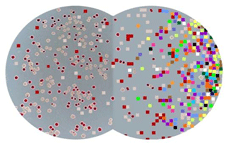Checking for contamination
Background
Phages T5 and T6 are used to confirm that the long-term lines (and other lines derived from the same founder) have not become contaminated. Both T5 and T6 are coli-phages; they do not attack most other species of bacteria. The particular E. coli B founding strain that we have used is T5 sensitive, but it is T6 resistant.
Sensitivity to T5 thus indicates that the strain in question is E. coli, while the combination of sensitivity to T5 and resistance to T6 strongly suggests that we have the correct strain of E. coli. This is especially compelling when taken together with presence of the appropriate Ara marker states in the experimental lines, because virtually all wild E. coli are Ara+ and most are resistant to T5. If there is any doubt, one can also check for T4-sensitivity (another phage to which E. coli B is sensitive) and various molecular genetic markers.
We have never seen an external E. coli contaminant on our plates, although we do occasionally see other bacterial contaminants.
Also, molecular genetic analyses (see especially the work on IS elements by Papadopoulos et al. 1999) confirm that our evolved lines are indeed derived from the ancestral strain and not from contaminants.
How to Do the Test
Take an LB (or TA) plate and mark a green line down the center back. Also label 6-8 strains that you will test by streaking across (perpendicular to) this line. Using sterile technique, withdraw about ~0.02 ml (~20 ul) from the phage stock, and drip onto the agar above one end of the green line. Immediately tilt the plate so that the phage stock runs the length of the line. The liquid should dry very quickly. Then, using sterile toothpicks, pick up a bit of a bacterial colony and streak it across the phage line, moving in one direction only. After all the colonies have been streaked, invert and incubate the plates at 37C overnight.
The next day, reading the results is usually quite simple. If the bacteria are sensitive, then the bacteria-streak should be "healthy" to the point where it crosses the phage-streak, then show lysis and disappear right at the phage-streak. (Sometimes it won't disappear entirely because resistant mutants can appear in the bacteria-streak or not all the cells contact phage. But in any case, there should be clear evidence that the bacteria-streak is disrupted by the phage-streak.) If the bacteria are resistant, then the bacteria-streak should continue uninterrupted across the phage-streak. There should be no sign of lysis, although occasionally there may a "waviness" of the bacteria-streak when it encounters and spreads at the added moisture of the phage-streak.
Because the experimental lines should all be resistant to T6, it is good to include a sensitive control. Most E. coli K12 strains are T6-sensitive and will serve well as a control.
When one gets comfortable with these phage-tests, one can actually put about 3 phage-streaks and 18 colony-streaks on a single plate. Draw three well-spaced green lines down the back of the plate. The center one can accommodate about 8 colony-streaks, and the other two about 5 each.
See Phage-Pharming for a protocol on preparing phage stocks.
